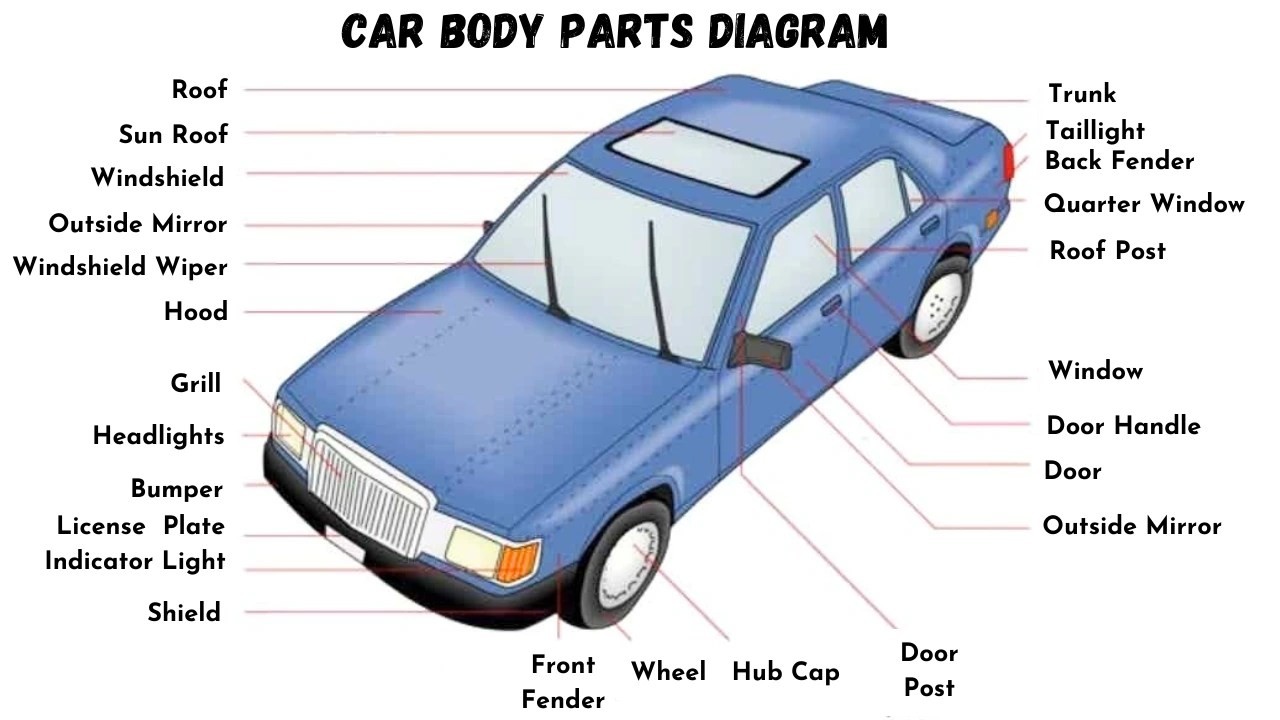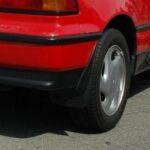Have you ever wondered about the names of all the different parts that make up your car’s exterior? Just like the human body, a car is composed of many parts working together. Knowing the names of these car exterior parts is not only fascinating but also helpful for maintenance, repairs, and even just understanding your vehicle better.
In this guide, we’ll explore the essential Car Exterior Parts Names, explaining what they are and their functions. Whether you’re a seasoned car enthusiast or a new car owner, this comprehensive breakdown will enhance your automotive knowledge.
Essential Car Exterior Parts and Their Functions
Here’s a detailed list of the main car exterior parts, categorized for easier understanding:
Front Exterior Car Parts
- Hood (or Bonnet): The hinged cover at the front of the car that provides access to the engine compartment. It protects the engine and other vital components from the elements.
- Front Bumper: Located at the frontmost part of the car, the bumper is designed to absorb impact in low-speed collisions, protecting the car’s body.
- Grille: Typically situated between the headlights, the grille allows air to flow to the radiator and engine, aiding in cooling. Grilles come in various designs and are often a key styling element of a car’s front fascia.
- Headlights: Essential for nighttime driving, headlights illuminate the road ahead, ensuring visibility and safety.
- Fog Lights: Positioned lower than headlights, fog lights are designed to improve visibility in foggy or misty conditions by directing light downwards.
- Indicator Lights (Turn Signals): Located at the front and rear, these blinking lights signal your intention to turn, ensuring safe lane changes and turns.
- Fenders (Wings): The panels that frame the wheel wells, fenders prevent dirt, mud, and debris from being thrown up by the tires.
- Fender Liners (Wheel Well Liners): Plastic or composite shields fitted inside the fenders to protect the underside of the fender and engine bay from road debris and moisture.
- Windshield Wipers: Mechanical arms with rubber blades that clear rain, snow, and debris from the windshield, maintaining clear visibility for the driver.
- Cowl Panel: The area at the base of the windshield, often housing the windshield wipers and vents for the car’s ventilation system.
Side Exterior Car Parts
- Doors: Hinged panels that provide access to the car’s interior. Cars can have two or four doors, depending on the model.
- Door Handles: Mechanisms used to open and close the car doors, available in various designs, from traditional handles to modern flush or pop-out styles.
- Window Glass: Transparent panels in the doors and body that allow visibility and light into the cabin, while protecting occupants from the elements.
- Quarter Window: Smaller windows located behind the rear doors or pillars, often found in sedans and SUVs, enhancing visibility and design.
- Mirrors (Side Mirrors): Mounted on the doors, side mirrors provide the driver with a view of the sides and rear of the vehicle, crucial for safe driving and maneuvering.
- Roof: The top panel of the car, providing structural integrity and protection from the elements. Roofs can vary in style, including standard, sunroof, or panoramic versions.
- Sunroof (Moonroof): An optional movable panel in the roof that can be opened to allow light and fresh air into the cabin.
Rear Exterior Car Parts
- Trunk (Boot or Decklid): The hinged cover at the rear of the car that provides access to the cargo compartment.
- Rear Bumper: Similar to the front bumper, the rear bumper is designed to protect the vehicle’s rear from damage in low-speed collisions.
- Taillights: Located at the rear, taillights include brake lights, turn signals, and parking lights, ensuring visibility and communication with other drivers, especially in low-light conditions and when braking.
- Number Plate (License Plate): A metal or plastic plate displaying the vehicle’s registration number, legally required for identification.
- Mud Flaps (Splash Guards): Attached behind the wheels, mud flaps reduce the spray of water, mud, and debris kicked up by the tires, protecting the car’s undercarriage and following vehicles.
- Rear Windshield: The glass panel at the rear of the car, providing rear visibility. Often equipped with a defroster and wiper in some models.
- Rear Spoiler: An aerodynamic device attached to the rear of the car, designed to improve stability and reduce drag at higher speeds. Often a styling element as well.
Wheels and Related Parts
- Wheels (Rims): The circular components to which tires are mounted, enabling the car to move. Wheels come in various materials, sizes, and designs, significantly impacting a car’s appearance and performance.
- Hubcap (Wheel Cap): A decorative cover for the center of the wheel, often used to conceal wheel bolts and enhance the wheel’s appearance.
Other Exterior Trim and Components
- Body Shell: The main structural frame of the car’s body, onto which all other body panels and components are attached.
- Body Side Molding (Trim): Protective or decorative strips along the sides of the car, designed to prevent door dings and scratches, while also adding a styling element.
- Bull Bar (Crash Guard): A robust bar, typically metal, mounted to the front or rear of a vehicle, designed to offer additional protection in collisions, especially in off-road conditions.
- Dashboard (Instrument Panel): While primarily an interior component, the top of the dashboard is often visible from the exterior through the windshield. It houses essential instruments and controls.
- Antenna: A rod or wire used to receive radio or GPS signals, traditionally mounted on the roof or fender, but increasingly integrated into the car’s design.
Car Body Parts Diagram
Understanding these car exterior parts names becomes even easier with a visual aid. Refer to this diagram for a clear illustration of where each part is located:
 Car Body Parts Diagram
Car Body Parts Diagram
Why Knowing Car Exterior Parts Names Matters
Familiarizing yourself with car exterior parts names offers several benefits:
- Improved Communication: When discussing car repairs or maintenance with mechanics or parts suppliers, using the correct terminology ensures clear and effective communication.
- Easier DIY Maintenance: Knowing part names helps when consulting repair manuals or online tutorials for DIY car maintenance and minor repairs.
- Better Understanding of Car Design: Appreciating the function of each part enhances your understanding of automotive engineering and design.
- Informed Purchasing Decisions: Whether buying replacement parts or considering vehicle modifications, knowing the names and functions of exterior parts empowers you to make informed decisions.
- Increased Car Knowledge: For car enthusiasts, knowing car exterior parts names is simply part of a broader passion and interest in automobiles.
Conclusion
From the hood to the taillights, each exterior part of a car plays a crucial role in its function, safety, and aesthetics. By learning these “car exterior parts names,” you’ve taken a significant step in becoming a more informed and engaged car owner or enthusiast. This knowledge not only enhances your understanding of your vehicle but also empowers you in various aspects of car ownership, maintenance, and appreciation. Whether you’re discussing repairs, planning modifications, or simply admiring automotive design, knowing the language of car parts is a valuable asset.

